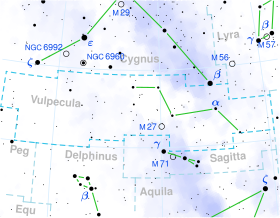
9 Aurigae is a star system in Auriga (constellation). It has an apparent magnitude of about 5, making it visible to the naked eye in many suburban skies. Parallax estimates made by the Hipparcos spacecraft put it at about 86 light-years from the solar system, although individual Gaia Data Release 3 parallaxes place all three components at 88 light years.
Mu Boötis, Latinized from μ Boötis, consists of a pair of double stars in the northern constellation of Boötes, 120 light-years from the Sun.
24 Cancri is a triple star system in the constellation Cancer. The system is located about 226 light-years away, based on its parallax. The system has a combined apparent magnitude of 6.5, and the two components A and B are separated by 5.7″.

IC 2391 is an open cluster in the constellation Vela consisting of hot, young, blueish stars, some of which binaries and one of which is a quadruple. Persian astronomer A. a.-R. Al Sufi first described it as "a nebulous star" in c. 964. It was re-found by Abbe Lacaille and cataloged as Lac II 5.
HD 4113 is a dual star system in the southern constellation of Sculptor. It is too faint to be viewed with the naked eye, having an apparent visual magnitude of 7.88. The distance to this star, as estimated by parallax measurements, is 137 light years. It is receding away from the Sun with a radial velocity of +5 km/s.
HD 115404 is a binary star system located in the constellation Coma Berenices. Parallax measurements made by Hipparcos put the system at 36 light-years, or 11 parsecs, away. The combined apparent magnitude of the system is 6.52, with the magnitudes of the components being 6.66 and 9.50.
HD 1185 is a double star in the northern constellation of Andromeda. The primary, with an apparent magnitude of 6.15, is a white main-sequence star of spectral type A2VpSi, indicating it has stronger silicon absorption lines than usual, thus making it also an Ap star. The secondary companion, which is 9.08 arcseconds away, is not visible to the naked eye at an apparent magnitude of 9.76. It shares common proper motion and parallax with the primary star but orbital parameters are still unknown.
HD 156768 is a double star in the southern constellation of Ara, with a combined apparent magnitude of 5.86. The brighter component is a sixth magnitude bright giant or supergiant star with a stellar classification of G8Ib/II. The magnitude 9.6 companion lies at an angular separation of 1.81″ along a position angle of 184°.
HD 135438 is a K-type giant star in the northern constellation of Boötes. With an apparent magnitude of 6.0, it lies about 650 light years away.
HAT-P-4 is a wide binary star consisting of a pair of G-type main-sequence stars in the constellation of Boötes. It is also designated BD+36°2593.

Iota Trianguli, Latinized from ι Trianguli, is a quadruple star system in constellation of Triangulum. The pair have a combined apparent magnitude of 4.95 and are approximately 290 light years from Earth.
HD 165189 and HD 165190 are components of a visual binary star system located 143 light years away in the southern constellation of Corona Australis. It is visible to the naked eye with the primary having an apparent visual magnitude of 4.929±0.025. The system is a member of the Beta Pictoris Moving Group.
HD 106515 is a binary star in the constellation of Virgo.

HD 102839 is a class G6Ib star in the constellation Musca. Its apparent magnitude is 4.98 and it is approximately 1,550 light years away from Earth based on parallax.

31 Orionis is a binary star system in the equatorial constellation of Orion, located near the bright star Mintaka. It is visible to the naked eye as a faint, orange-hued point of light with a baseline apparent visual magnitude of 4.71. The distance to this system is approximately 490 light years away based on parallax, and it is drifting further away with a mean radial velocity of +6 km/s.

1 Puppis is a single star in the southern constellation of Puppis. It lies in the northern part of the constellation at a distance of about 790 ly, east of Aludra in Canis Major and just north of the white supergiant, 3 Puppis. This object is visible to the naked eye as a faint, red-hued star with an apparent visual magnitude of 4.59. It is moving further from the Earth with a heliocentric radial velocity of +32.4 km/s.

HD 59890 is a class G3Ib yellow supergiant star in the constellation Puppis. Its apparent magnitude is 4.65 and it is approximately 1,360 light years away based on parallax.

HD 59612 is a class A5Ib supergiant star in the constellation Puppis. Its apparent magnitude is 4.86 and it is approximately 4,300 light years away based on parallax.
7 Tauri is a multiple star in the northern constellation of Taurus. It has a combined apparent visual magnitude of 5.95, so, according to the Bortle scale, it is faintly visible from suburban skies at night. Measurements made with the Gaia spacecraft show an annual parallax shift of 5.5 mas, which is equivalent to a distance of around 593 light years from the Sun.






